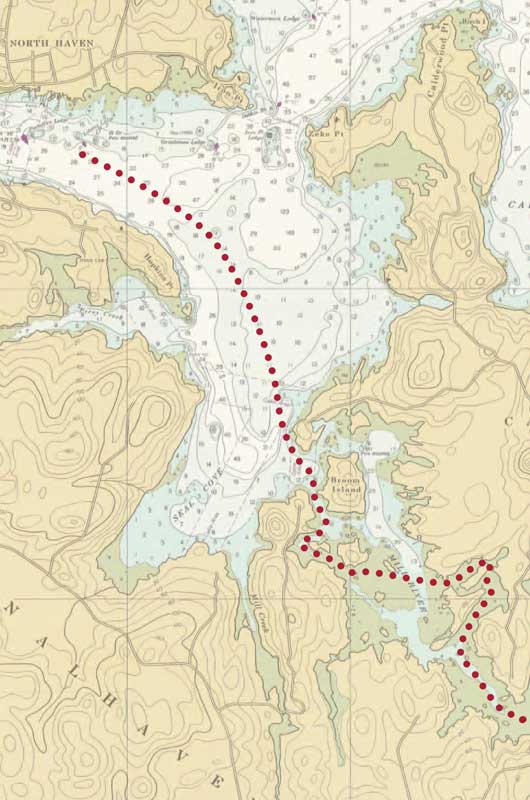Photographs by Alison Langley
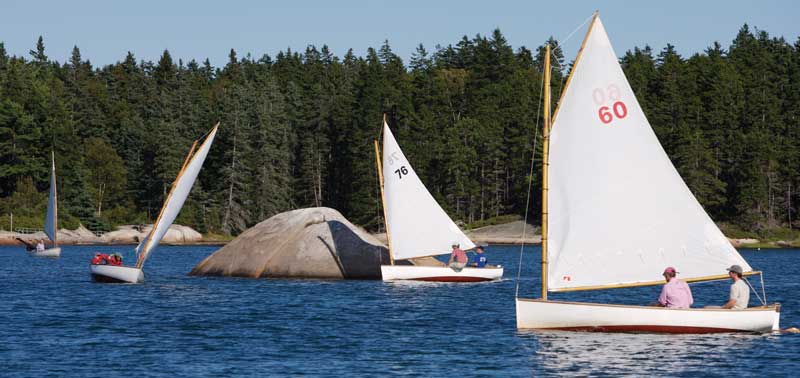
A group of teenagers who spent their summers messing about in North Haven Dinghies began the Mill River Race as a lark in 1910, but it proved to be a hit. Almost a century later, the race is still going strong.
Each summer on a day when the tide peaks in the mid afternoon, North Haven Dinghies race down the Fox Islands Thoroughfare, up Vinalhaven’s Seal Cove, and into an inner basin known as Mill River. They wind their way around various islands and rocks, round a mark at the head of the basin, and race back, finishing in the Thoroughfare in front of the North Haven yacht club, known locally as the Casino.
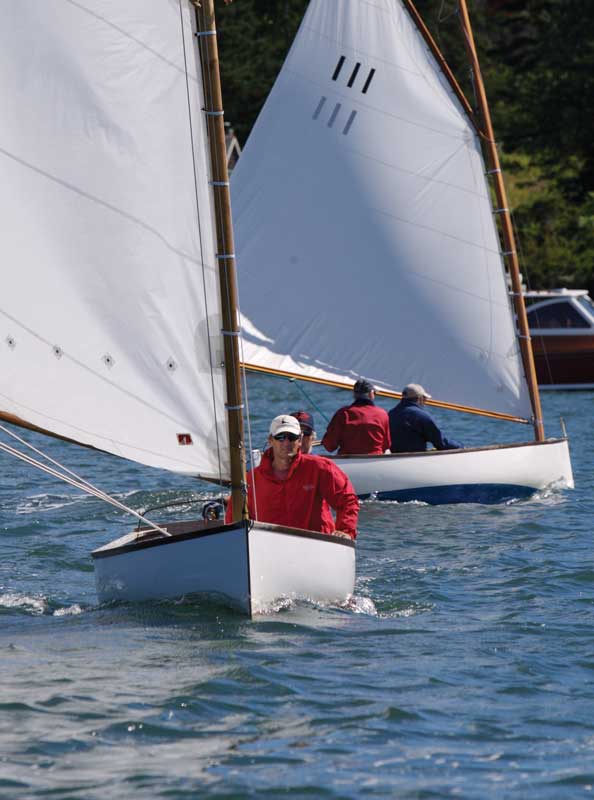
Once in the “river”—it’s not really a river, rather a channel between the main bulk of Vinalhaven and Calderwood Neck—all rules of the road are suspended except port-starboard and rock room. Things get tight as the dinghies squeeze through tiny passages, some little more than a boat-length wide. Even on windy days, the breezes are unstable, as small islands and big rocks create random lees that can stop the lead boats and allow those in the back of the fleet to ease alongside.
The free-for-all is compounded by strong tidal currents, submerged rocks, and the dozens of spectators on the basin’s many small islands, picnicking and cheering on the contestants.
This magazine’s publisher, John K. Hanson, Jr., learned first hand the extent of the latter distraction. In his first time in the race, he crewed for his then future mother-in-law, Emily Lewis, who led the fleet in the river until she stopped focusing on her boat to greet a friend on shore. Just at that moment another boat, skippered by Emily’s husband George, ghosted past them to starboard. (Hanson and Lewis teamed up again some years later to avenge themselves with a win.)
The Mill River Race is one of a handful of non-traditional courses sailed in the Fox Islands, many in North Haven Dinghies, gaff-rigged catboats thought by many to be the world’s oldest one-design class. The concept of race as obstacle course dates back to the early days when the Fox Islands in Penobscot Bay first became a popular summer destination for wealthy Boston families. Adults raced the boats over traditional courses, while their children used the craft to get around in and have fun.
Among the teenagers who first conceived of the Mill River Race was a young man named Robert Codman Cobb, whose family spent winters in the Boston area. Cobb kept a detailed journal of his escapades. He was 17 in 1910 when he and his friend Eleanor Wheeler decided to use winnings from a sweepstakes knockabout event as the prize for a Mill River Race, according to the journal that now belongs to his children, including Lydia Cobb Perkins of Concord, Massachusetts.
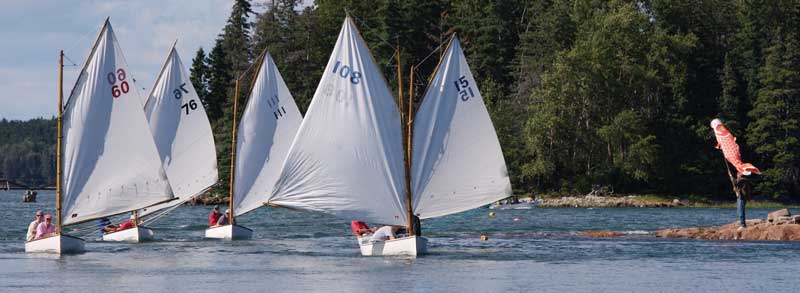
Robert described sailing Eleanor’s North Haven Dinghy Cinch up Mill River with a canoe in tow to set a flag on Sunday, September 4. They set the mark, then anchored the dinghy and took off exploring in the canoe until it capsized in the river-like tidal currents under the bridge between Calderwood Neck and the rest of Vinalhaven.
Since the canoe had been borrowed without permission from Eleanor’s parents, the teenagers tried to hide the evidence of their outing. Eleanor went so far as to put her wet clothes in a bureau drawer before going downstairs for lunch in a clean, dry outfit, according to Perkins who interviewed her years later about the incident.
The next day, Monday, September 5, three young sailors started the race but were unable to finish due to lack of wind. The race was held again on September 6 in a “good east breeze.” Cobb held second place until he ran aground in “the shortcut” for 10 minutes and finished next to last. The next year, in a race run in a foul, rainy easterly, Cobb ran aground again and fouled out because he “had to get out and walk.”
For many years racers could choose their own route in and out of the inlet, until some time in the 1950s or 1960s, Cobb changed the rules. David Parsons, a long-time summer resident who learned about North Haven Dinghy racing by crewing for his father as a young boy, recalls the day.
“There was a meeting and he drew the course on the chart,” says Parsons. “I remember watching him do it. He just did it. There was a lot of confusion prior to that on how people should go.”
The compromise solution was to set the course into the river and let racers choose their own way out.
A perennial challenge of the race out has been a narrow eelgrass- and rock-encrusted bar near the head of the inlet. Some years the tide covers enough of the bar to allow the lead racers to sail across, which results in a considerably shorter route—this likely is the shortcut referred to in Cobb’s journal. As he noted, the short-cut can turn out to be the long way if the tide is too high and the boat runs aground.
The North Haven Dinghy class dates back to the early 1880s, when summer residents began racing in spritsail-rigged dinghies. Summer resident William Weld took on the fleet in 1883 with a tender from his big yacht Gitana. He lost, and when he went home to Massachusetts he had a faster boat built. The next summer he beat all challengers, prompting his brother, Dr. Charles C. Weld, to commission four copies from builder James O. Brown of North Haven. Dr. Weld eventually helped Brown start the boatyard that still functions today as J.O. Brown & Son and is run by Brown’s great-grandchildren.
Those first four boats began racing in 1885, according to an early account by Tucker Daland, one of the summer colony’s founders and owner of one of the four new boats. The design was modified from a spritsail to a gaff rig with the mast set in the eyes of the boat. The first “official” race of the modified boats took place in August 1887. The dates are important, because the Water Wags of Dublin, Ireland, also began racing in 1887, in April. Some argue that this makes the Water Wag the world’s oldest one-design, but others note that North Haven began racing a version of its dinghy in 1885, even though the design was later modified.
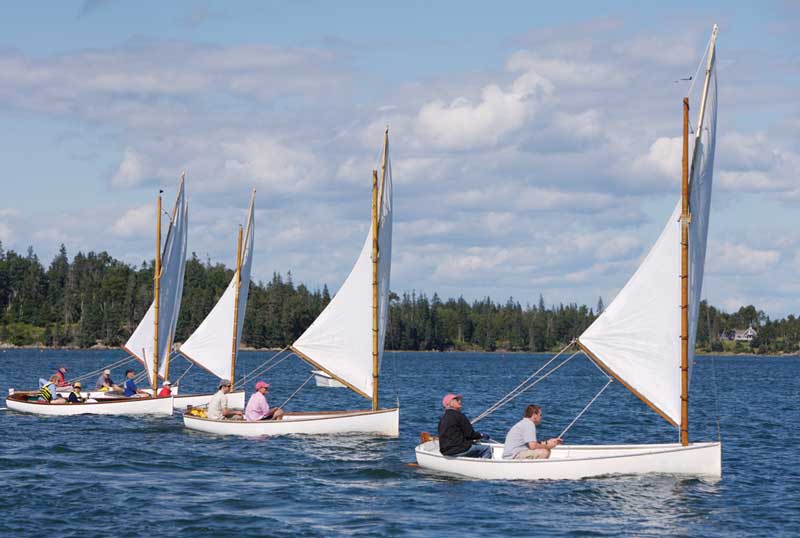
In any event, during the summer of 1887 contemporaries described two races off North Haven. The first involved just women and was won by Ellen Hayward (Eleanor Wheeler’s mother), who went on to compete against two men, Dr. Weld and Charles K. Cobb (Robert Codman Cobb’s father). The men, both seasoned yachtsmen, got into a luffing match, allowing Hayward, a far less experienced racer, to sail past both and win. Her prize, given by Dr. Weld, was a sloop named Wayward, which she and her husband sailed on Penobscot Bay for many years, according to an account she wrote much later in life.
The rules of the class were solidified in 1919, when the yacht designer John Alden’s firm was hired to record the lines of the boats. Sam Crocker was part of the team that drew up that first set of plans. The firm produced a second set of drawings in 1925, including plans for a Bermudan sloop rig that was never used.
The fleet grew to 50 or more and remained quite healthy until the early 1970s, when the old wooden boats, many almost a century old, became difficult to maintain. A group of summer residents, including Richard Saltonstall, Jr., and his first cousin George Lewis, Jr., had a fiberglass mold made. Most of the boats racing today are fiberglass.
The shallow draft of the North Haven dinghies (13 inches with the centerboard up and almost 4 feet with it down) and big sail (118 square feet) make them surprisingly fast, especially downwind with the peak lowered and the centerboard up. But the boats also carry 350 pounds of lead ballast, which gives them the heft of a much larger boat and precludes quick moves.

Today, the fleet includes more than 20 fiberglass boats, although only about a dozen race on a regular basis. Ten turned out for last summer’s Mill River Race, which was won by Ben Hammond and his wife Kate after years of trying. An experienced dinghy sailor who raced on Harvard University’s sailing team for four years and campaigned in Snipes and J-24s, Hammond said he always has done well getting to the river mouth, but has been undone in past years by fickle breezes and other problems.
“One year I didn’t know which way to go around an island, the next I hit a rock,” Hammond said.
The race remains one of his favorites, especially now that he finally has won it.
“It’s gorgeous in there with the rocks and trees and the random spectators,” he said. “It’s one of the best venues for a race I’ve ever been in.”
Polly Saltonstall is a freelance journalist who grew up sailing North Haven Dinghies. There was one in her family as early as 1904.






